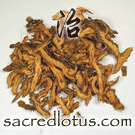Huang Lian (Coptis Rhizome)
Herb 3 of 7 in Herbs that Clear Heat and Dry Dampness
Buy This Herb
Get free shipping from
our partners at CHD
our partners at CHD
Chinese Herb Actions
-
Drains Fire and Relieves Toxins
For fire symptoms such as high fever, irritability, delirium, red tongue, and full and rapid pulse. Also for heat with toxicity causing painful red eyes, sore throat, and for toxic skin lesions. - Drains Dampness and Clears Heat
For Damp-Heat in the stomach with vomiting or acid regurgitation, or stomach fire with bad breath and belching with a foul smell, and for Damp-Heat in the intestines with diarrhea or dysentery. - Calms Heart Fire
For insomnia due to the Heart and Kidneys miscommunication. - Clears Heat, Stops Bleeding
For epistaxis, Blood in the stool, urine, or vomit. - Used topically to clear heat in the eyes, tongue, and mouth.
Chinese Herb Contraindications & Cautions
- Caution in cases of Yin or blood deficiency, stomach cold, or diarrhea from spleen and kidney deficiency. Long term use may injure the spleen and stomach. Some traditional sources say this herb should not be taken with pork, and may antagonize Radix Scrophulariae Ningpoensis (xuan shen), Flos Chrysanthemi Morifolii (ju hua), Bombyx Batryticatus (jiang can), Cortex Dictamni Dasycarpi Radicis (bai xian pi), and Radix Achyranthis Bidentatae, (niu xi).
Herb-Drug Interactions
- Section not completed...
Chinese Herb Toxicity & Overdose
- Section not completed...
Chinese Herb Dosage
- 1.5-9 grams.
Chinese Herb Notes
- Dry-fried to enhance the cooling properties and to allow entrance into the blood, use with ginger to treat stomach heat, use with salt to clear heat in the large intestine and bladder, and can be used topically as a powder.
This Herb Appears in the Following Formulas:
- An Gong Niu Huang Wan (Calm the Palace Pill with Cattle Gallstone)
Category: Formulas that Clear Heat and Open the Orifices - Bai Tou Weng Tang (Pulsatilla Decoction)
Category: Formulas that Clear Heat from the Organs - Ban Xia Xie Xin Tang (Pinellia Decoction to Drain the Epigastrium)
Category: Formulas that Harmonize the Stomach and Intestines - Dang Gui Liu Huang Tang (Tangkuei and Six Yellow Decoction)
Category: Formulas that Stabilize the Exterior and the Lungs - Fei Er Wan (Fat Baby Pill)
Category: Formulas that Expel Parasites - Ge Gen Huang Lian Huang Qin Tang (Kudzu, Coptis, and Scutellaria Decoction)
Category: Formulas that Release Exterior-Interior Excess - Huang Lian e Jiao Tang (Coptis and Ass Hide Gelatin Decoction)
Category: Formulas that Nourish the Heart and Calm the Spirit - Huang Lian Jie Du Tang (Coptis Decoction to Relieve Toxicity)
Category: Formulas that Clear Heat and Relieve Toxicity - Jian Pi Wan (Strengthen the Spleen Pill)
Category: Formulas that Reduce Food Stagnation - Lian Po Yin (Coptis and Magnolia Bark Decoction)
Category: Formulas that Clear Damp-Heat - Mu Xiang Bing Lang Wan (Aucklandia and Betel Nut Pill)
Category: Formulas that Reduce Food Stagnation - Pu Ji Xiao Du Yin (Universal Benefit Decoction to Eliminate Toxins)
Category: Formulas that Clear Heat and Relieve Toxicity - Qing Shu Yi Qi Tang (Clear Summerheat and Augment the Qi Decoction)
Category: Formulas that Relieve Summerheat - Qing Wei San (Clear the Stomach Powder)
Category: Formulas that Clear Heat from the Organs - Qing Wen Bai Du Yin (Clear Epidemics and Overcome Toxins Decoction)
Category: Formulas that Clear Heat and Relieve Toxicity - Qing Ying Tang (Clear the Nutritive Level Decoction)
Category: Formulas that Clear Heat from the Nutritive Level and Cool the Blood - Shao Yao Tang (Peony Decoction)
Category: Formulas that Clear Damp-Heat - Shi Gao Tang (Gypsum Decoction)
Category: Formulas that Release Exterior-Interior Excess - Wu Mei Wan (Mume Pill)
Category: Formulas that Expel Parasites - Xiao Xian Xiong Tang (Minor Sinking Into the Chest Decoction)
Category: Formulas that Clear Heat and Transform Phlegm - Xie Xin Tang (Drain the Epigastrium Decoction)
Category: Formulas that Clear Heat and Relieve Toxicity - Zhi Shi Xiao Pi Wan (Immature Bitter Orange Pill to Reduce Focal Distension)
Category: Formulas that Reduce Food Stagnation - Zhong Man Fen Xiao Wan (Separate and Reduce Fullness in the Middle Pill)
Category: Formulas that Clear Damp-Heat - Zhu Sha An Shen Wan (Cinnabar Pill to Calm the Spirit)
Category: Formulas that Sedate and Calm the Spirit - Zuo Jin Wan (Left Metal Pill)
Category: Formulas that Clear Heat from the Organs






